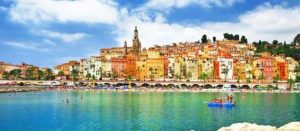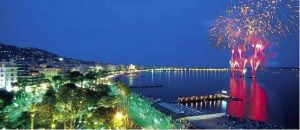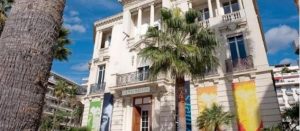SEPTEMBER 5TH, 2018
THE LOWDOWN ON CANNES
While Cannes may not be a powerhouse of historic sights, it has a freewheeling sort of charm that encourages visitors to relax and explore. The obvious place to start is La Croisette, the waterfront promenade that provides one of the main stages for the glamour and gold for which the Côte d’Azur is rightly famous. It’s also a great place to go people watching and you may even spot a celebrity. La Croisette is home to the Palais des Festivals, the location for the world-famous Cannes Film Festival, as well as numerous palace hotels, the belle époque Carlton and the art deco Majestic and Hotel Martinez to name but a few.
The old town of Cannes, concentrated on Suquet Hill, remains a warren of steep, sinuous streets and alleys with a wonderful old-world atmosphere. An 11th-century former church at the top of the hill is now the Musée de la Castre, which affords amazing views from its tower. And if you need an escape from the Riviera hustle and bustle, consider an excursion to one or both of the Îles de Lérins, located 15 minutes offshore. Île Sainte-Marguérite is a lovely nature preserve, but also hosts several fancy eateries and the Fort Royal, which was once the home of the Man in the Iron Mask. Île Saint-Honorat has a fascinating 1500-year-old fortified monastery to offer.

AFTERHOURS IN CANNES
As this article fromTelegraph Travel makes clear, Cannes has some serious star quality in terms of nightlife too. Le Baoli, a stone’s throw from Port Pierre-Canto (one of the venues for the Cannes Yachting Festival) is a premiere after-hours location, with a clientele and prices to match. The vintage art deco bar-lounge, cabaret scene and nightclub Chrystie consists of numerous distinct spaces arranged around a huge central bar. Gotha, the largest club in Cannes, is the place for big-name DJs and bigger-name actor patrons.
Zoa is primarily a sushi bar, but also plays live or DJ music until the small hours, and, being across the street from the Palais des Festivals, tends to attract a plentiful crowd of a certain standing. More subdued La Chunga is a piano and live music bar with a 1950s ambiance, while L’Amiral in Hotel Martinez boasts live jazz pianists in an art deco backdrop for a more discerning crowd. Last but not least, the contemporary Casino Croisette is another great place to while away some euros or enjoy the bar and restaurant overlooking the port.

UNMISSABLE MUSEUMS
Although more famous for its parties and beaches than its cultural offerings, Cannes has plenty of the latter – this is France, after all. The chic and intimate La Malmaison art centre, housed in the building of the former Grand Hotel, hosts temporary exhibitions of work from renowned 20th and 21st century artists such as Picasso and Chagall. The Musée de la Castre at the top of Suquet Hill has an eclectic collection including mediaeval artefacts, Asian instruments and paintings from the 19th century. The Villa Domergue, built in 1934, exhibits the work of prominent 20th century painters Jean-Gabriel Domergue and Odette Maudrange-Domergue, who also drew the villa and the terraced gardens. Situated on a beautiful hillside above Cannes, the villa provides opulent views of the city and the bay below.
Cannes is also the home of several impressive art galleries, such as Galerie Hurtebize, which specialises in post-impressionist and modern art (including work by Renoir), Galerie Vieceli, founded in 2005 and dedicated to contemporary artists, Galerie Neel, which hosts a range of contemporary art collected by the owners over many years in the United States and Japan, or Galerie Carlton, located within the Carlton Hotel and displaying unique paintings, sculpture and glassware by artists that include Matisse, Picasso, Renoir and Chagall. The Espace Miramar is situated on the ground floor of the old Hotel Miramar, which was built in 1929, and dedicated to photography and the visual arts; during the film festival, it also screens movies in its large auditorium.

DAY TRIPS AND EXCURSIONS
Cannes may be Europe’s capital of see-and-be-seen, but you don’t need to travel far to escape the crowd and experience world-class natural beauty and ancient vestiges. The village of Gourdon, with its ninth-century castle, cobbled streets, quaint buildings and delicious local restaurants, is one of those perched Provençal villages for which the term ‘picturesque’ seems to have been invented. The way there is hugely scenic in itself, with wonderful vistas of the surrounding mountains and the river Loup. Another charming town is Villefranche-sur-Mer, with a quaint old centre and mediaeval port. And further fabulous views are on offer in Grasse, the perfume capital of the world, which is surrounded by enchanting fields of flowers and home to the International Perfume Museum, among other sights.
More natural attractions can be found in the mountains north of Cannes. One is the Clue d’Aiglun, a complex of pools, cascades, waterfalls and limestone caves on the river Estéron nestled amid pine-covered mountainsides. There are also alpine resorts nearby, such as Gréolières, which provide first-rate skiing in winter and beautiful hikes in summer, as well as horseback riding or mountain biking adventures.



